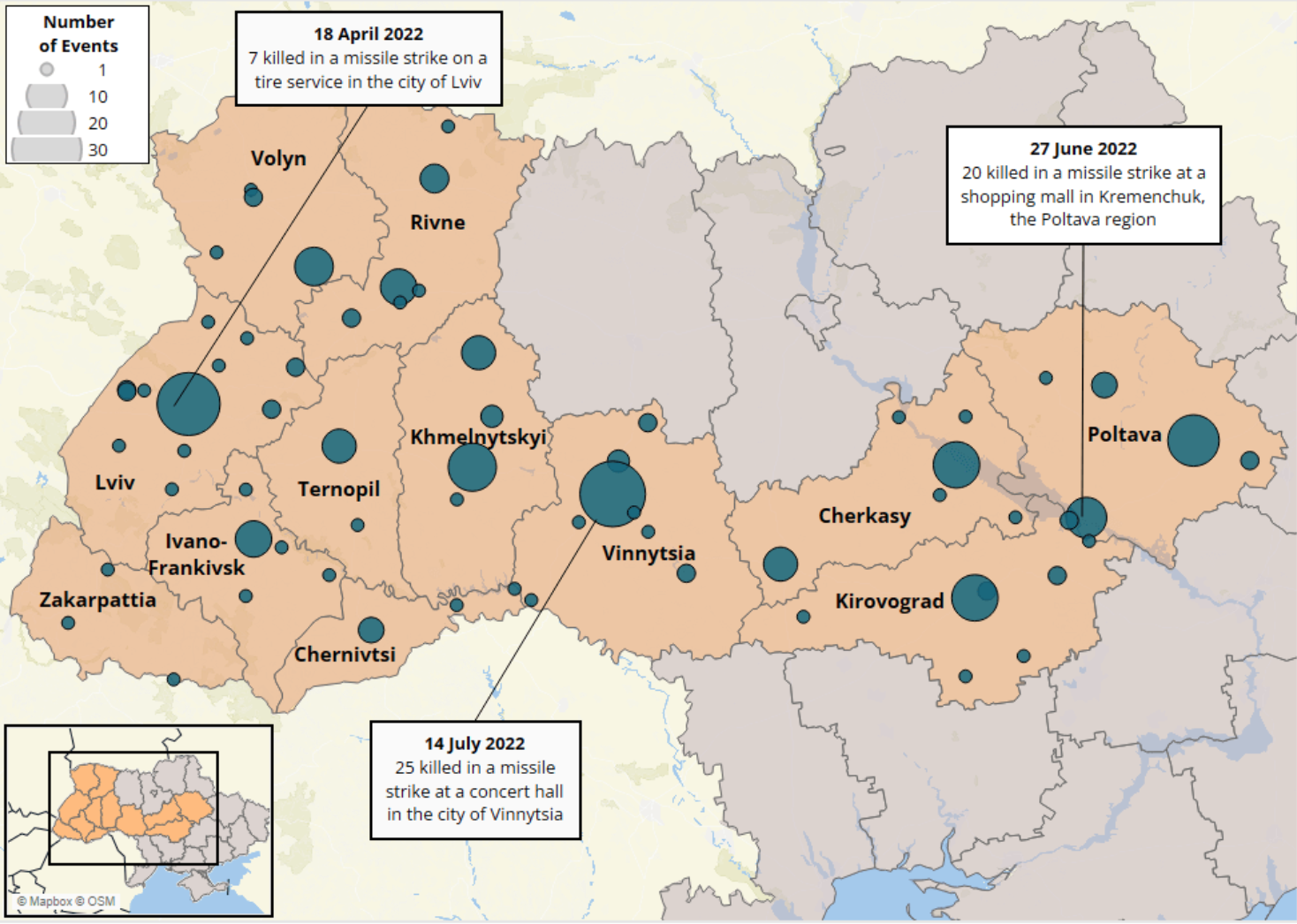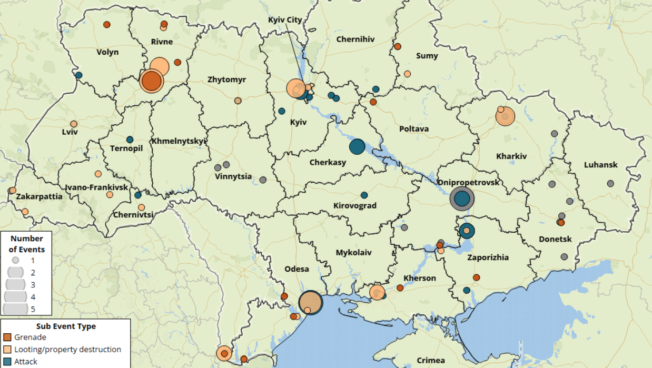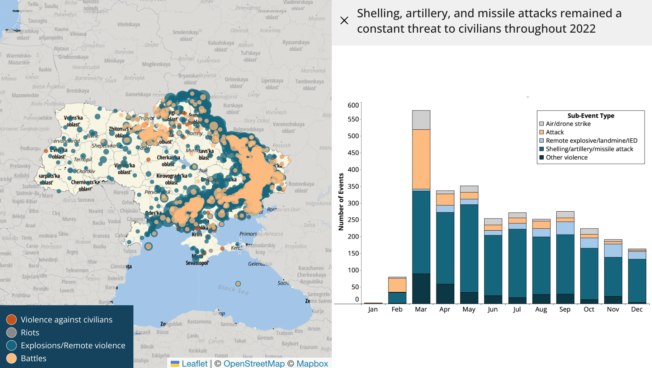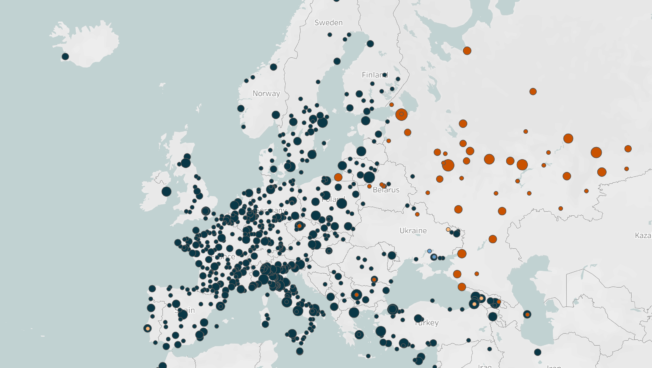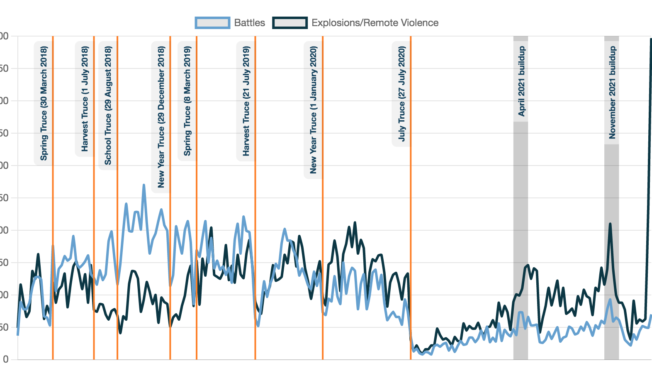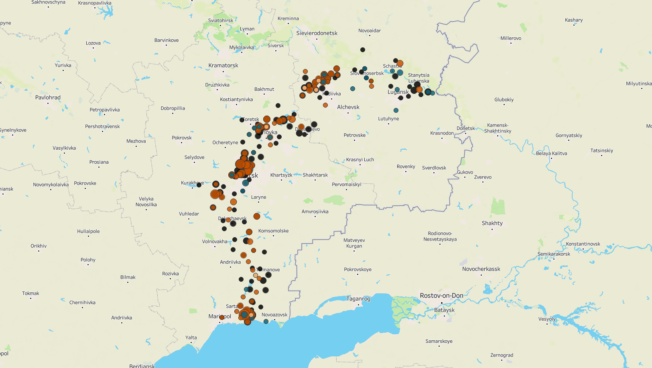Featured Report
War in Ukraine: One Year On, Nowhere Safe
This report analyzes key trends in ACLED data since the start of the Russian invasion.
ACLED’s Ukraine Conflict Monitor provides near real-time information on the war, including an interactive map of the latest data from the start of the invasion onward, a curated data file, and weekly situation updates.
The Monitor is designed to help researchers, policymakers, media, and the wider public track key conflict developments in Ukraine over the course of the war. It is updated every Wednesday, with data covering events from the previous week. ACLED data reflect the best available information at the time of release, and are regularly updated as new or better information becomes available.
Due to the methodological limitations of event-based data collection, in addition to the broader challenges around fatality reporting in fast-moving conflict contexts like Ukraine, fatality estimates in the ACLED dataset pertain specifically to those fatalities reported in connection with distinct events that meet ACLED’s catchment and minimum threshold for inclusion (i.e. date, location, and actor information). This means that aggregate tallies provided by sources such as hospitals and government agencies, for example, which cannot be broken down and connected to individual conflict incidents, are not included in the ACLED dataset. ACLED fatality numbers are conservative event-based estimates, and the full death toll in such contexts is likely higher than the number of reported fatalities currently attributed to the type of distinct incidents that can be captured in the dataset. For these reasons, the Monitor will not be providing regular fatality estimate updates at this time.1Tracking fatalities is one of the most difficult aspects of conflict data collection in general, as fatality counts are frequently the most biased, inconsistent, and poorly documented components of conflict reporting, and this is especially true of active conflict environments impacted by high levels of mis/disinformation and severe access constraints. ACLED defaults to conservative estimates based on the best available information at the time of coding in line with our specific event-based methodology and review process. ACLED estimates are restricted to fatalities reported during individual events, meaning that these estimates may be particularly conservative in comparison with sources that do not use an event-based methodology. When and where possible, ACLED researchers seek out information to triangulate the numbers from any report, but we do not independently verify fatalities. ACLED is also a ‘living dataset’, so all fatality figures are revised and corrected — upward or downward — if new or better information becomes available (which, in some conflict contexts, can be months or years after an event has taken place). These figures should therefore be understood as indicative estimates rather than definitive fatality counts (for more on ACLED’s approach to coding fatalities, see FAQs: ACLED Fatality Methodology). ACLED additionally only captures fatalities that are directly caused by political violence; indirect conflict-related fatalities caused by disease or starvation, for example, are not included in these estimates. Other sources may come to different figures due to differing methodologies and catchments.
24 – 30 June 2023
Intense fighting continued in the Donetsk region, with Ukrainian forces claiming territorial gains in the areas of Bakhmut and Avdiivka. Fighting also continued on both sides of the administrative boundary between the Donetsk and Zaporizhia regions, where Ukrainian forces made limited advances. Elsewhere in the Zaporizhia region, Ukrainian and Russian forces clashed south and southeast of Orikhiv, while Ukrainian forces also reportedly conducted long-range strikes on Russian positions in Melitopol and Berdiansk. Clashes also continued along the Kreminna-Svatove-Kupiansk line in the Luhansk and Kharkiv regions.
Russian shelling, missiles, and airstrikes reportedly killed over 40 civilians in Kyiv city and Dnipropetrovsk, Donetsk, Kharkiv, Kherson, Sumy, and Zaporizhia regions. In the Donetsk region, Russian missiles hit a cafe in Kramatorsk on 27 June, killing 13 civilians, including three minors, and wounding at least 60. In the capital city of Kyiv, debris of a Russian missile hit a multi-storey residential building on 24 June, killing five civilians and wounding 11 others. .
For previous situation updates and infographics, click here.
Interactive Dashboard
This dashboard includes political violence events in Ukraine since the start of the Russian invasion on 24 February 2022. By default, the map displays data for the most recent week. Use the filters on the left to analyze trends in more detail.
Curated Data
This file contains all political violence events, demonstration events, and strategic developments recorded in Ukraine and the Black Sea from the beginning of ACLED coverage in 2018 to the present.
For an overview, see our interactive dashboard.
Information & Analysis
For additional information on the conflict in Ukraine, check our analysis of political violence trends from the start of ACLED coverage in 2018.


